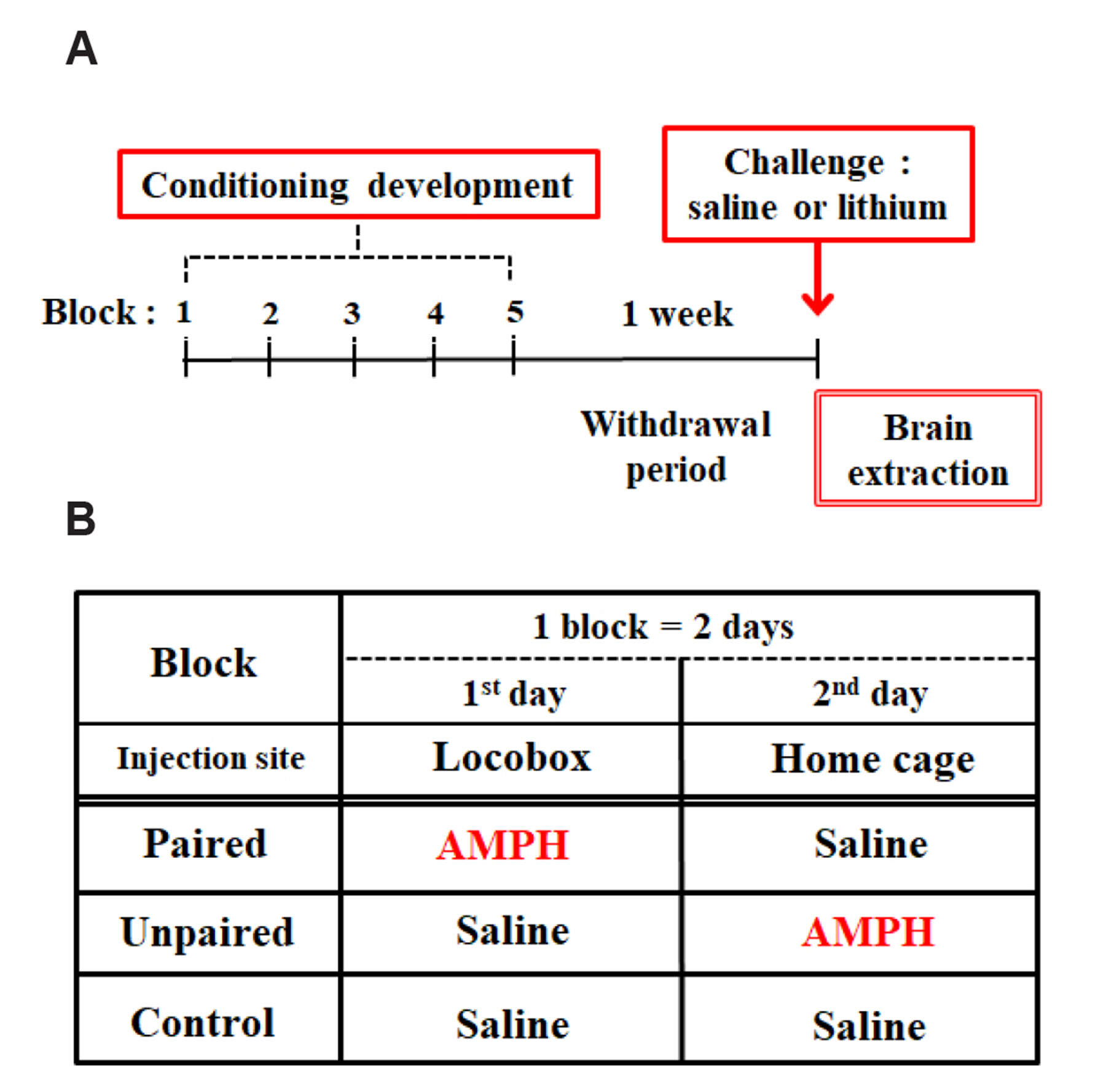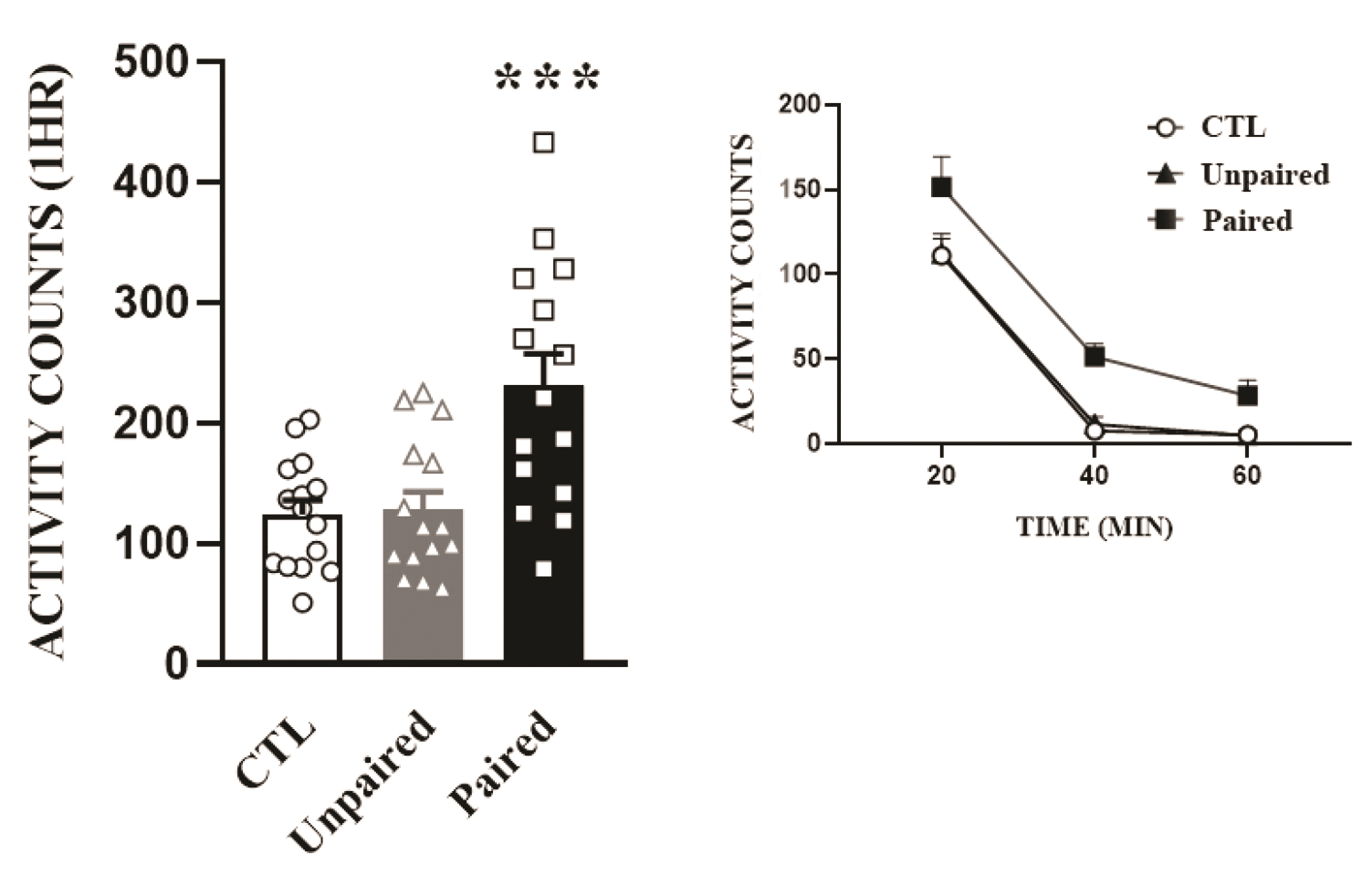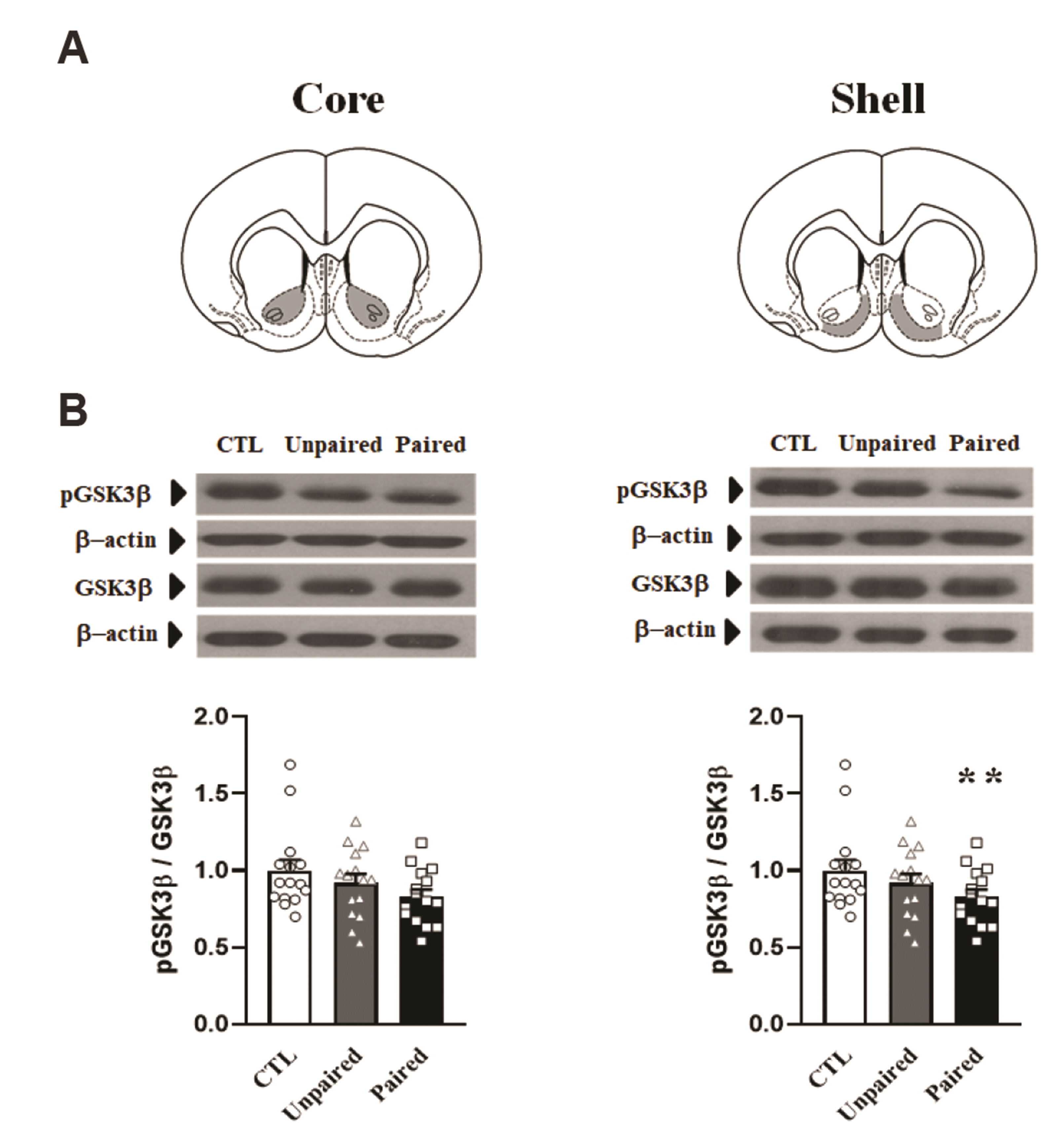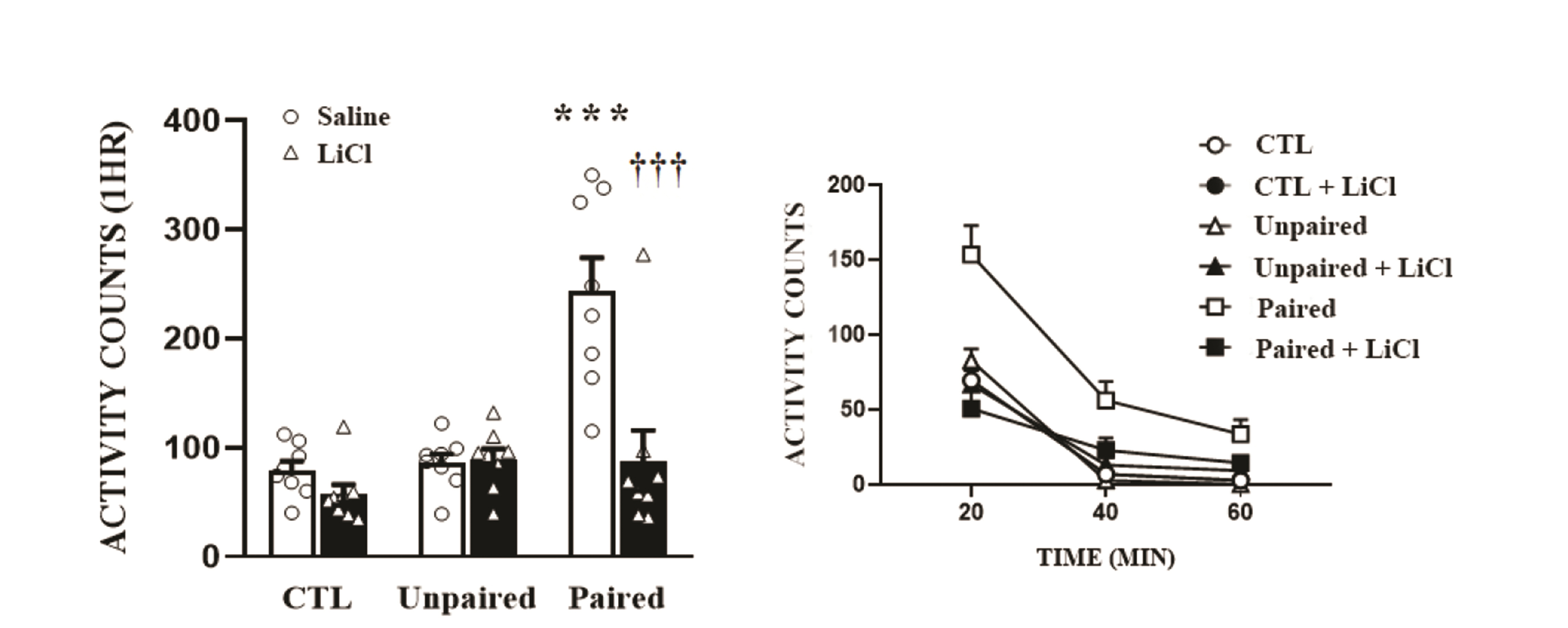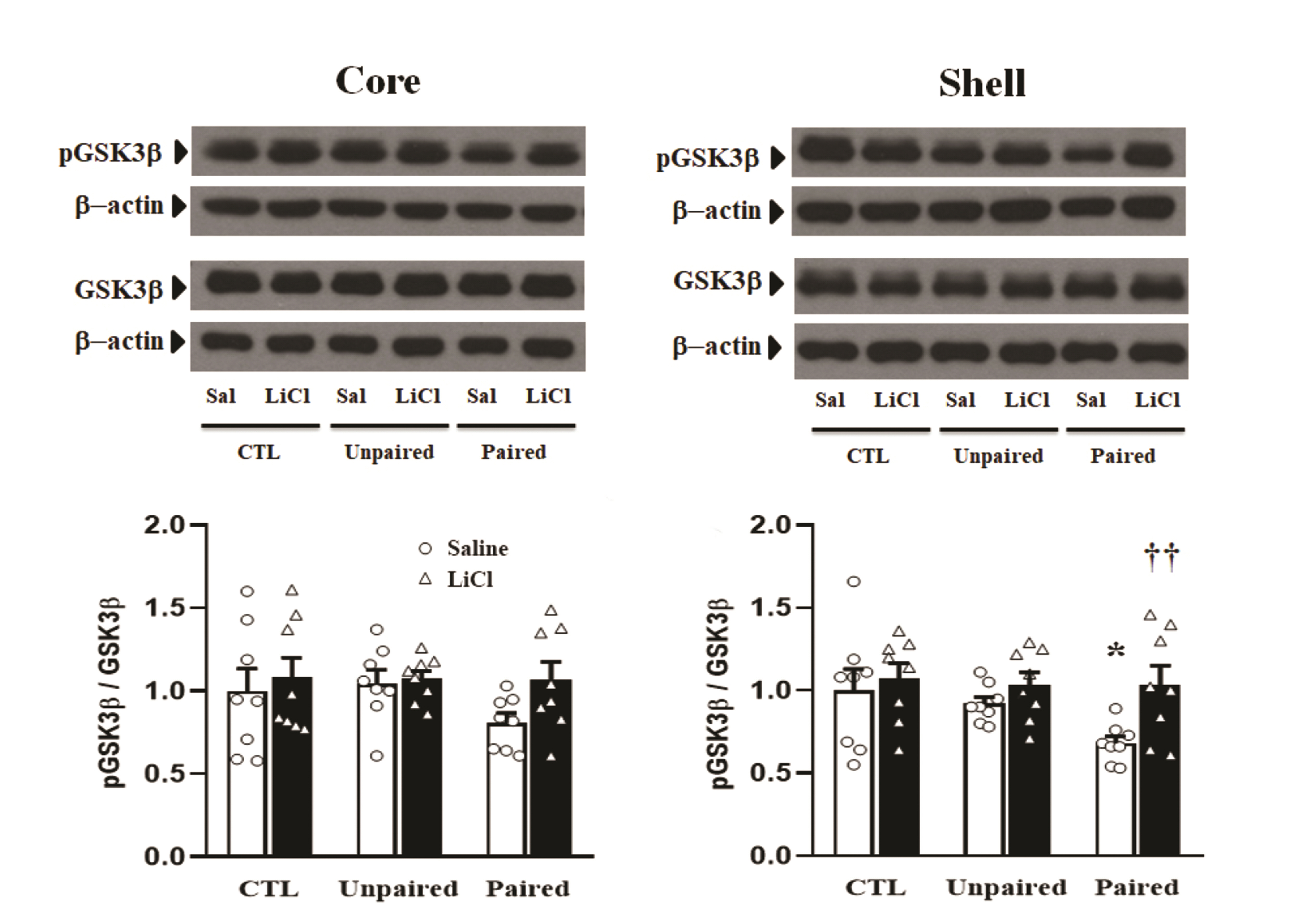Korean J Physiol Pharmacol.
2022 Jan;26(1):59-65. 10.4196/kjpp.2022.26.1.59.
Decrease of glycogen synthase kinase 3β phosphorylation in the rat nucleus accumbens shell is necessary for amphetamineinduced conditioned locomotor activity
- Affiliations
-
- 1Departments of Physiology, Yonsei University College of Medicine, Seoul 03722, Korea
- 2Departments of Medical Sciences, Yonsei University College of Medicine, Seoul 03722, Korea
- KMID: 2524531
- DOI: http://doi.org/10.4196/kjpp.2022.26.1.59
Abstract
- Phosphorylation levels of glycogen synthase kinase 3β (GSK3β) negatively correlated with psychomotor stimulant-induced locomotor activity. Locomotor sensitization induced by psychomotor stimulants was previously shown to selectively accompany the decrease of GSK3β phosphorylation in the nucleus accumbens (NAcc) core, suggesting that intact GSK3β activity in this region is necessary for psychomotor stimulants to produce locomotor sensitization. Similarly, GSK3β in the NAcc was also implicated in mediating the conditioned effects formed by the associations of psychomotor stimulants. However, it remains undetermined whether GSK3β plays a differential role in the two sub-regions (core and shell) of the NAcc in the expression of drug-conditioned behaviors. In the present study, we found that GSK3β phosphorylation was significantly lower in the NAcc shell obtained from rats expressing amphetamine (AMPH)-induced conditioned locomotor activity. Further, we demonstrated that these effects were normalized by treatment with lithium chloride, a GSK3β inhibitor. These results suggest that the behavior produced by AMPH itself and a conditioned behavior formed by associations with AMPH are differentially mediated by the two sub-regions of the NAcc.
Figure
Reference
-
1. Robbins TW, Cador M, Taylor JR, Everitt BJ. 1989; Limbic-striatal interactions in reward-related processes. Neurosci Biobehav Rev. 13:155–162. DOI: 10.1016/S0149-7634(89)80025-9. PMID: 2682402.
Article2. Kalivas PW, Stewart J. 1991; Dopamine transmission in the initiation and expression of drug- and stress-induced sensitization of motor activity. Brain Res Brain Res Rev. 16:223–244. DOI: 10.1016/0165-0173(91)90007-U. PMID: 1665095.
Article3. Hyman SE. 1996; Addiction to cocaine and amphetamine. Neuron. 16:901–904. DOI: 10.1016/S0896-6273(00)80111-7.
Article4. Goto Y, Grace AA. 2008; Limbic and cortical information processing in the nucleus accumbens. Trends Neurosci. 31:552–558. DOI: 10.1016/j.tins.2008.08.002. PMID: 18786735. PMCID: PMC2884964.
Article5. Beaulieu JM, Gainetdinov RR, Caron MG. 2007; The Akt-GSK-3 signaling cascade in the actions of dopamine. Trends Pharmacol Sci. 28:166–172. DOI: 10.1016/j.tips.2007.02.006. PMID: 17349698.
Article6. Beaulieu JM, Gainetdinov RR, Caron MG. 2009; Akt/GSK3 signaling in the action of psychotropic drugs. Annu Rev Pharmacol Toxicol. 49:327–347. DOI: 10.1146/annurev.pharmtox.011008.145634. PMID: 18928402.
Article7. Leroy K, Brion JP. 1999; Developmental expression and localization of glycogen synthase kinase-3beta in rat brain. J Chem Neuroanat. 16:279–293. DOI: 10.1016/S0891-0618(99)00012-5. PMID: 10450875.8. Dajani R, Fraser E, Roe SM, Young N, Good V, Dale TC, Pearl LH. 2001; Crystal structure of glycogen synthase kinase 3 beta: structural basis for phosphate-primed substrate specificity and autoinhibition. Cell. 105:721–732. DOI: 10.1016/S0092-8674(01)00374-9. PMID: 11440715.9. Frame S, Cohen P, Biondi RM. 2001; A common phosphate binding site explains the unique substrate specificity of GSK3 and its inactivation by phosphorylation. Mol Cell. 7:1321–1327. DOI: 10.1016/S1097-2765(01)00253-2. PMID: 11430833.
Article10. Miller JS, Tallarida RJ, Unterwald EM. 2009; Cocaine-induced hyperactivity and sensitization are dependent on GSK3. Neuropharmacology. 56:1116–1123. DOI: 10.1016/j.neuropharm.2009.03.006. PMID: 19328817. PMCID: PMC2721824.
Article11. Xu CM, Wang J, Wu P, Zhu WL, Li QQ, Xue YX, Zhai HF, Shi J, Lu L. 2009; Glycogen synthase kinase 3beta in the nucleus accumbens core mediates cocaine-induced behavioral sensitization. J Neurochem. 111:1357–1368. DOI: 10.1111/j.1471-4159.2009.06414.x. PMID: 19799712.12. Xu CM, Wang J, Wu P, Xue YX, Zhu WL, Li QQ, Zhai HF, Shi J, Lu L. 2011; Glycogen synthase kinase 3β in the nucleus accumbens core is critical for methamphetamine-induced behavioral sensitization. J Neurochem. 118:126–139. DOI: 10.1111/j.1471-4159.2011.07281.x. PMID: 21517846.
Article13. Enman NM, Unterwald EM. 2012; Inhibition of GSK3 attenuates amphetamine-induced hyperactivity and sensitization in the mouse. Behav Brain Res. 231:217–225. DOI: 10.1016/j.bbr.2012.03.027. PMID: 22649795. PMCID: PMC3566781.
Article14. Kim WY, Jang JK, Lee JW, Jang H, Kim JH. 2013; Decrease of GSK3β phosphorylation in the rat nucleus accumbens core enhances cocaine-induced hyper-locomotor activity. J Neurochem. 125:642–648. DOI: 10.1111/jnc.12222. PMID: 23439225.
Article15. Jongen-Rêlo AL, Voorn P, Groenewegen HJ. 1994; Immunohistochemical characterization of the shell and core territories of the nucleus accumbens in the rat. Eur J Neurosci. 6:1255–1264. DOI: 10.1111/j.1460-9568.1994.tb00315.x. PMID: 7526940.
Article16. Zahm DS. 2000; An integrative neuroanatomical perspective on some subcortical substrates of adaptive responding with emphasis on the nucleus accumbens. Neurosci Biobehav Rev. 24:85–105. DOI: 10.1016/S0149-7634(99)00065-2. PMID: 10654664.
Article17. Meredith GE, Baldo BA, Andrezjewski ME, Kelley AE. 2008; The structural basis for mapping behavior onto the ventral striatum and its subdivisions. Brain Struct Funct. 213:17–27. DOI: 10.1007/s00429-008-0175-3. PMID: 18256852. PMCID: PMC2556127.
Article18. Stewart J, Vezina P. Kalivas PW, Barnes CD, editors. 1988. Conditioning and behavioral sensitization. Sensitization in the nervous system. Telford Press;Caldwell: p. 207–224.19. O'Brien CP, Childress AR, McLellan AT, Ehrman R. 1992; Classical conditioning in drug-dependent humans. Ann N Y Acad Sci. 654:400–415. DOI: 10.1111/j.1749-6632.1992.tb25984.x. PMID: 1632593.20. Domjan M. 2005; Pavlovian conditioning: a functional perspective. Annu Rev Psychol. 56:179–206. DOI: 10.1146/annurev.psych.55.090902.141409. PMID: 15709933.
Article21. Tzschentke TM. 2007; Measuring reward with the conditioned place preference (CPP) paradigm: update of the last decade. Addict Biol. 12:227–462. DOI: 10.1111/j.1369-1600.2007.00070.x. PMID: 17678505.
Article22. Miller JS, Barr JL, Harper LJ, Poole RL, Gould TJ, Unterwald EM. 2014; The GSK3 signaling pathway is activated by cocaine and is critical for cocaine conditioned reward in mice. PLoS One. 9:e88026. DOI: 10.1371/journal.pone.0088026. PMID: 24505362. PMCID: PMC3913742.
Article23. Shi X, Miller JS, Harper LJ, Poole RL, Gould TJ, Unterwald EM. 2014; Reactivation of cocaine reward memory engages the Akt/GSK3/mTOR signaling pathway and can be disrupted by GSK3 inhibition. Psychopharmacology (Berl). 231:3109–3118. DOI: 10.1007/s00213-014-3491-8. PMID: 24595501. PMCID: PMC4110417.
Article24. Wickens RH, Quartarone SE, Beninger RJ. 2017; Inhibition of glycogen synthase kinase-3 by SB 216763 affects acquisition at lower doses than expression of amphetamine-conditioned place preference in rats. Behav Pharmacol. 28:262–271. DOI: 10.1097/FBP.0000000000000283. PMID: 27984209.
Article25. Shi X, Barr JL, von Weltin E, Wolsh C, Unterwald EM. 2019; Differential roles of accumbal GSK3β in cocaine versus morphine-induced place preference, U50,488H-induced place aversion, and object memory. J Pharmacol Exp Ther. 371:339–347. DOI: 10.1124/jpet.119.259283. PMID: 31420527. PMCID: PMC6800444.
Article26. Franklin TR, Druhan JP. 2000; Involvement of the nucleus accumbens and medial prefrontal cortex in the expression of conditioned hyperactivity to a cocaine-associated environment in rats. Neuropsychopharmacology. 23:633–644. DOI: 10.1016/S0893-133X(00)00162-7. PMID: 11063919.
Article27. Kim WY, Vezina P, Kim JH. 2008; Blockade of group II, but not group I, mGluRs in the rat nucleus accumbens inhibits the expression of conditioned hyperactivity in an amphetamine-associated environment. Behav Brain Res. 191:62–66. DOI: 10.1016/j.bbr.2008.03.010. PMID: 18433894.
Article28. Yoon HS, Kim WY, Kim JH. 2010; Microinjection of CART peptide 55-102 into the nucleus accumbens core inhibits the expression of conditioned hyperactivity in a cocaine-associated environment. Behav Brain Res. 207:169–173. DOI: 10.1016/j.bbr.2009.10.003. PMID: 19818812.
Article29. Bossert JM, Poles GC, Wihbey KA, Koya E, Shaham Y. 2007; Differential effects of blockade of dopamine D1-family receptors in nucleus accumbens core or shell on reinstatement of heroin seeking induced by contextual and discrete cues. J Neurosci. 27:12655–12663. DOI: 10.1523/JNEUROSCI.3926-07.2007. PMID: 18003845. PMCID: PMC2117350.
Article30. Fuchs RA, Ramirez DR, Bell GH. 2008; Nucleus accumbens shell and core involvement in drug context-induced reinstatement of cocaine seeking in rats. Psychopharmacology (Berl). 200:545–556. DOI: 10.1007/s00213-008-1234-4. PMID: 18597075. PMCID: PMC2613506.
Article31. Chaudhri N, Sahuque LL, Schairer WW, Janak PH. 2010; Separable roles of the nucleus accumbens core and shell in context- and cue-induced alcohol-seeking. Neuropsychopharmacology. 35:783–791. DOI: 10.1038/npp.2009.187. PMID: 19924113. PMCID: PMC2813976.
Article32. Xie X, Lasseter HC, Ramirez DR, Ponds KL, Wells AM, Fuchs RA. 2012; Subregion-specific role of glutamate receptors in the nucleus accumbens on drug context-induced reinstatement of cocaine-seeking behavior in rats. Addict Biol. 17:287–299. DOI: 10.1111/j.1369-1600.2011.00325.x. PMID: 21521425. PMCID: PMC4384648.
Article33. Cruz FC, Babin KR, Leao RM, Goldart EM, Bossert JM, Shaham Y, Hope BT. 2014; Role of nucleus accumbens shell neuronal ensembles in context-induced reinstatement of cocaine-seeking. J Neurosci. 34:7437–7446. DOI: 10.1523/JNEUROSCI.0238-14.2014. PMID: 24872549. PMCID: PMC4035511.
Article34. Singer BF, Forneris J, Vezina P. 2014; Inhibiting cyclin-dependent kinase 5 in the nucleus accumbens enhances the expression of amphetamine-induced locomotor conditioning. Behav Brain Res. 275:96–100. DOI: 10.1016/j.bbr.2014.08.055. PMID: 25196634. PMCID: PMC4253310.
Article35. Singer BF, Bubula N, Li D, Przybycien-Szymanska MM, Bindokas VP, Vezina P. 2016; Drug-paired contextual stimuli increase dendritic spine dynamics in select nucleus accumbens neurons. Neuropsychopharmacology. 41:2178–2187. DOI: 10.1038/npp.2016.39. PMID: 26979294. PMCID: PMC4908651.
Article36. Beaulieu JM, Caron MG. 2008; Looking at lithium: molecular moods and complex behaviour. Mol Interv. 8:230–241. DOI: 10.1124/mi.8.5.8. PMID: 19015387.
Article37. Beaulieu JM, Del'guidice T, Sotnikova TD, Lemasson M, Gainetdinov RR. 2011; Beyond cAMP: the regulation of Akt and GSK3 by dopamine receptors. Front Mol Neurosci. 4:38. DOI: 10.3389/fnmol.2011.00038. PMID: 22065948. PMCID: PMC3206544.
Article38. Kim WY, Cai WT, Jang JK, Kim JH. 2020; Ezrin-radixin-moesin proteins are regulated by Akt-GSK3β signaling in the rat nucleus accumbens core. Korean J Physiol Pharmacol. 24:121–126. DOI: 10.4196/kjpp.2020.24.1.121. PMID: 31908581. PMCID: PMC6940492.
Article39. Paxinos G, Watson C. 2004. The rat brain in stereotaxic coordinates. Elsevier Academic Press;Boston:
- Full Text Links
- Actions
-
Cited
- CITED
-
- Close
- Share
- Similar articles
-
- Ezrin-radixin-moesin proteins are regulated by Akt-GSK3β signaling in the rat nucleus accumbens core
- Lithium alleviates paralysis in experimental autoimmune neuritis in Lewis rats by modulating glycogen synthase kinase-3β activity
- The effect of insulin on glycogen synthase activity in individualskeletal muscle in rat
- Lithium ameliorates rat spinal cord injury by suppressing glycogen synthase kinase-3β and activating heme oxygenase-1
- Blockade of ERK Phosphorylation in the Nucleus Accumbens Inhibits the Expression of Cocaine-induced Behavioral Sensitization in Rats

